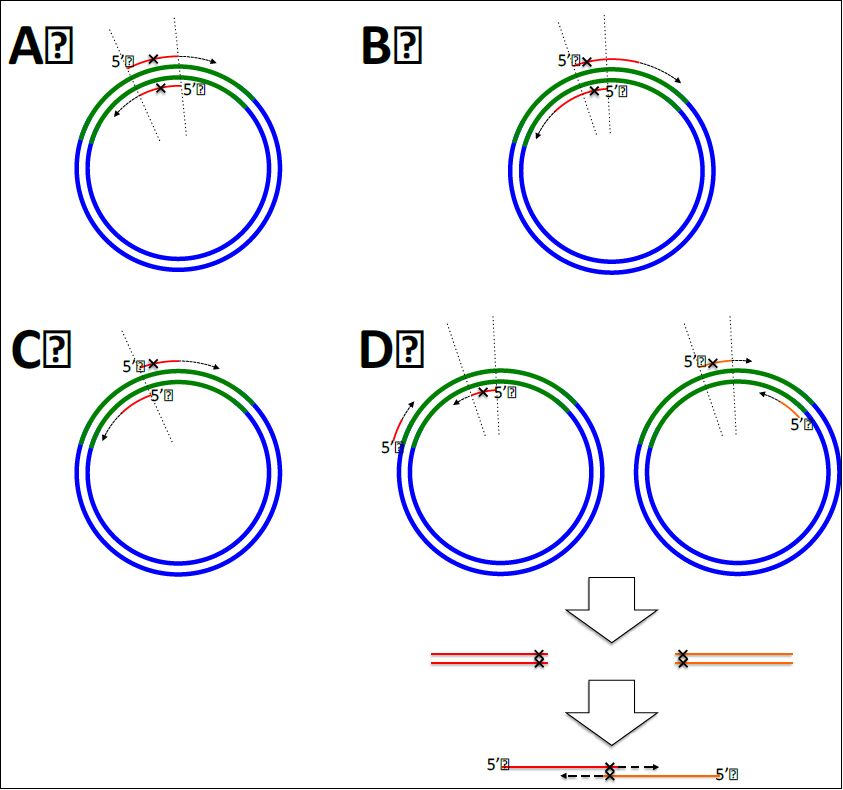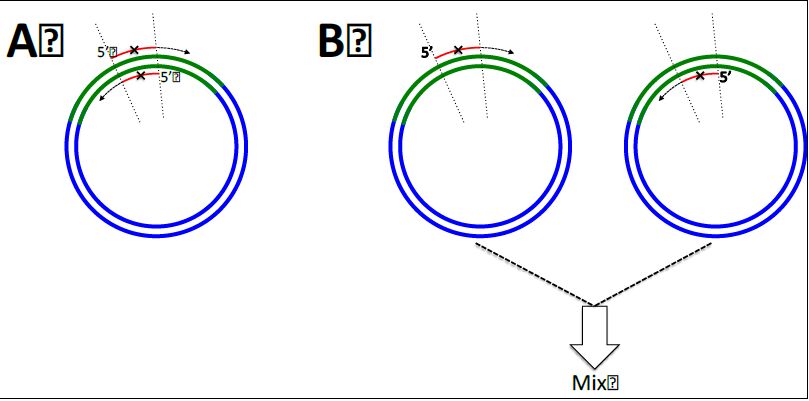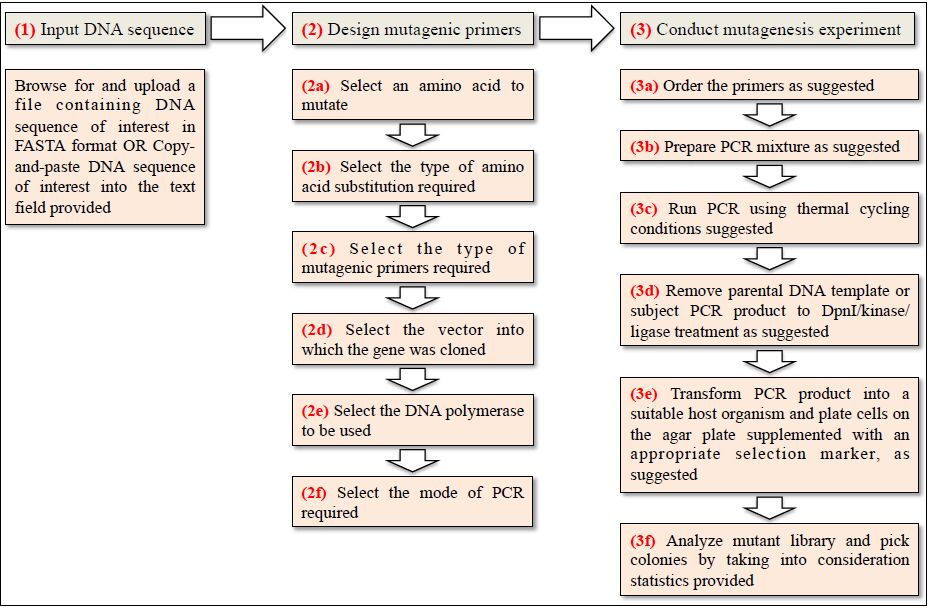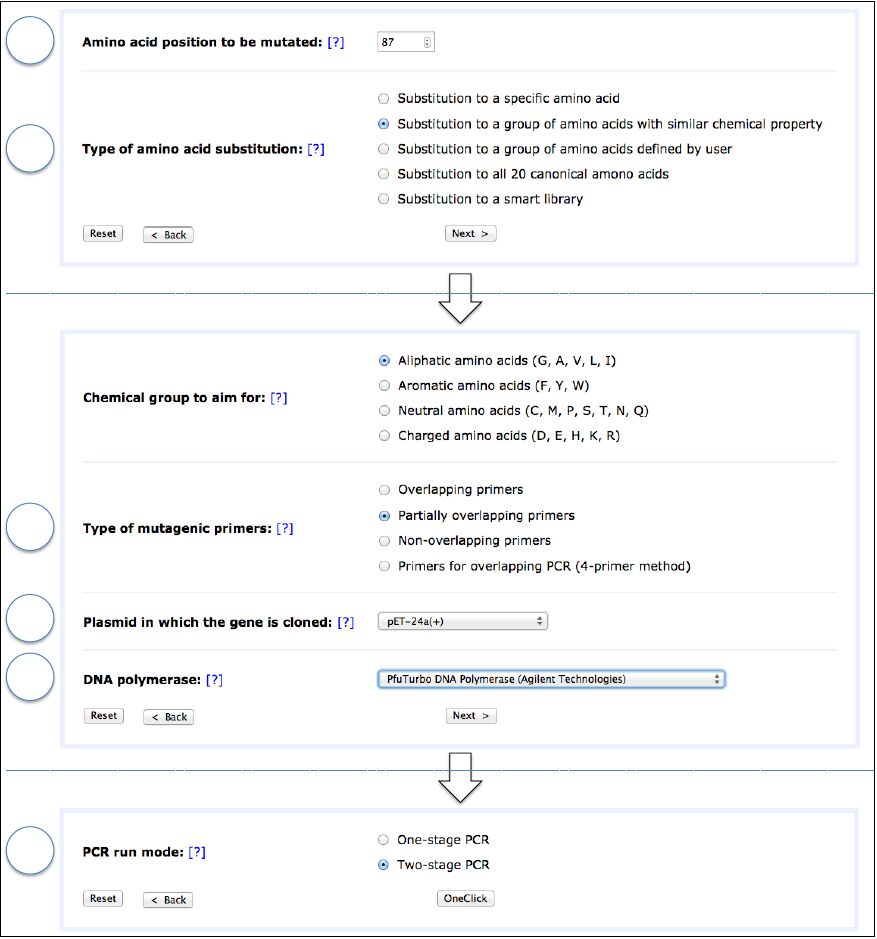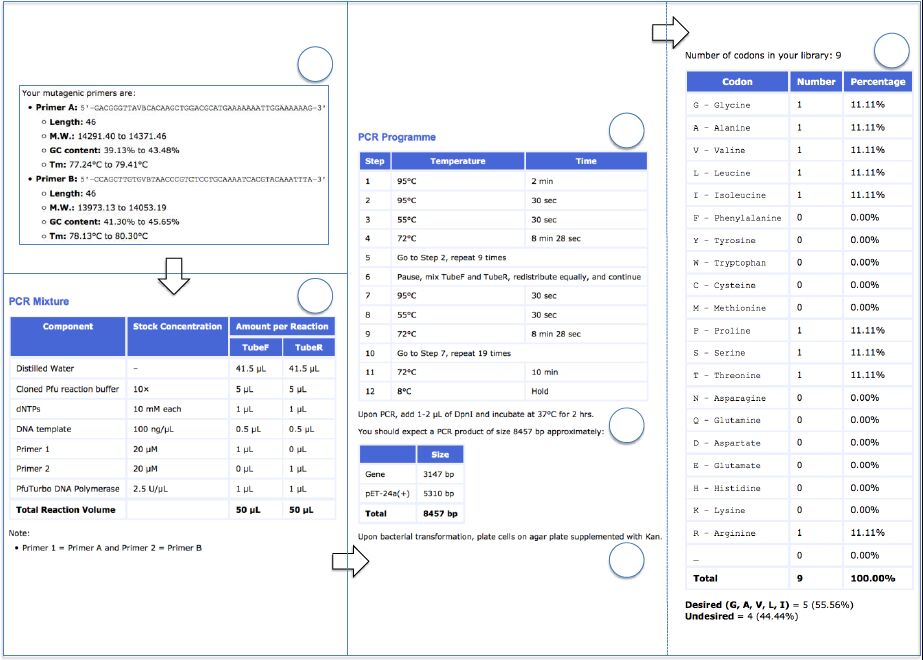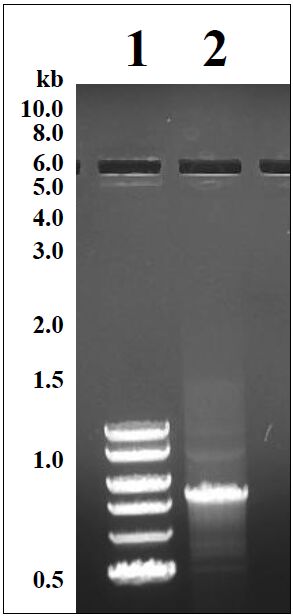1. Introduction
Since the first use of site-directed mutagenesis to modify the active sites of tyrosyl-tRNA synthetase (TyrRS) and β-lactamase in the 1980s [1,2,3], protein engineering has continued to contribute to our understanding of protein structure, folding and enzymatic mechanism [4]. Many engineered proteins are now applied in industry and disease treatment (e.g., lipases, proteases, carbohydrases and antibodies).
Molecular methods to engineer proteins can broadly be classified into 4 categories: 1) random mutagenesis, 2) focused mutagenesis (e.g., site-directed mutagenesis, saturation mutagenesis), 3) DNA recombination and 4) combined approach [5,6]. A recent survey of 100 directed evolution articles, published between 2011-2013, revealed that random mutagenesis is the most popular method of choice, used in 47% of the papers reported [5]. This is followed by focused mutagenesis, which was applied in 23% of the papers surveyed [5]. Among these focused mutagenesis experiments, the QuikChange method of linear whole-plasmid amplification was most frequently used (46%), followed by overlapping PCR or 4-primer method (22%) and QuikChange derivatives (16%).
Many molecular biology kits are now commercially available for focused mutagenesis. Notable examples include QuikChange II and QuikChange Lightning from Agilent Technologies, Q5® from New England Biolabs, GeneArt® from Thermo Fisher Scientific, etc. The popularity of these kits has also prompted the manufacturers to develop computational tool to facilitate the design of mutagenic primers (Table 1). Most of these tools are specific to the kits they accompany (e.g., type of mutagenic primer and DNA polymerase).
Table 1. Programs available for designing mutagenic primers.
Over the years, many clever mutagenic primer designs have been proposed to increase PCR efficiency of focused mutagenesis [5]. Further, more sophisticated DNA polymerases (e.g., higher fidelity, processivity and extension rate) have been introduced, which are well suited for whole-plasmid amplification and for difficult-to-amplify plasmids. However, the field of protein engineering is lacking a design platform that encompasses all these options that are readily available for focused mutagenesis.
In this article, we describe the development and demonstrate the application of our OneClick program, which is an algorithm to design the entire process of a focused mutagenesis experiment (i.e., from mutagenic primer to bacterial transformation) and to analyze the resultant mutant library.
2. Materials and Method
2.1. Implementation
A PERL script was written to read the input DNA sequence, analyze it, translate it into its corresponding protein sequence, analyze the protein sequence, design mutagenic primers and mutagenesis experiment, and provide statistical analyses. This was subsequently developed into a Perl CGI web application, using HTML5, CSS3 and JavaScript with the jQuery library to receive client-side-validated input from webforms. Perl CGI was used to parse input data, perform server-side validation, and keep track of intermediate (session) data throughout each step of the application. The Template Toolkit assisted with the creation of web pages and the display of output data.
2.2. IUPAC notations
In OneClick, IUPAC notations are used in reporting a primer sequence (Table 2).
Table 2. IUPAC notations used in OneClick.
| Symbol |
Description |
Nucleobase |
| A |
Adenine |
A |
|
|
|
| C |
Cytosine |
|
C |
|
|
| G |
Guanine |
|
|
G |
|
| T |
Thymine |
|
|
|
T |
| W |
Weak interaction |
A |
|
|
T |
| S |
Strong interaction |
|
C |
G |
|
| M |
Amino |
A |
C |
|
|
| K |
Keto |
|
|
G |
T |
| R |
Purine |
A |
|
G |
|
| Y |
Pyrimidine |
|
C |
|
T |
| B |
Not A (B comes after A) |
|
C |
G |
T |
| D |
Not C (D comes after C) |
A |
|
G |
T |
| H |
Not G (H comes after G) |
A |
C |
|
T |
| V |
Not T or U (V comes after U) |
A |
C |
G |
|
| N |
Any nucleotide |
A |
C |
G |
T |
2.3. Types of amino acid substitution and amino acid classification
OneClick allows 5 types of amino acid substitution (Table 3). In type (ii) substitution, amino acids are grouped into 4 categories, depending on the chemical nature of their side-chains: (iia) aliphatic, (iib) aromatic,(iic) neutral and (iid) charged, identical to the categorization used in the Mutagenesis Assistant Program (MAP; [7,8]). In type (v) substitution, a smart library comprises 12 amino acids [9]. This set of amino acids is a balanced mix of polar and nonpolar, aliphatic and aromatic, and negatively and positively charged amino acids, while excluding structurally/chemically similar amino acids.
Table 3. Types of amino acid substitution in OneClick.
| Amino acid substitution |
Codon |
Amino acid |
| (i)Substitution to a specific amino acid |
1 |
User’s choice |
| (ii)Substitution to a group of amino acids with similar chemical property |
|
|
| (iia) Aliphatic |
VBC |
G, A, V, L, I |
| (iib) Aromatic |
TDK |
F, Y, W |
| (iic) Neutral |
HNK |
C, M, P, S, T, N, Q |
| (iid) Charged |
VRW |
D, E, H, K, R |
| (iii)Substitution to a group of amino acids defined by user |
2 |
User’s choice |
| (iv)Substitution to all 20 canonical amino acids |
NNK |
G, A, V, L, I, F, Y, W, C, M, |
|
|
P, S, T, N, Q, D, E, H, K, R |
| (v)Substitution to a smart library |
NDT |
G, V, L, I, F, Y, C, S, N, D, H, R |
1Most frequent codon is assigned based on expression host chosen.
2Codon is assigned to maximize the occurrence of desired amino acids. Rare codon is avoided. |
2.4. Mutagenic primer type and primer design
OneClick is capable of designing 4 types of mutagenic primer, which have comprehensively been summarized in a recent review article (Figure 1; [5]): (i) overlapping primers, (ii) partially overlapping primers, (iii) non-overlapping primers and (iv) primers for overlapping PCR (4-primer method). The design rules for each mutagenic primer type are summarized in Table 4.
Table 4. Mutagenic primer design rules used in OneClick.
| Mutagenic primer type |
Sequence (5’-3’)1 |
Length |
Number of overlapping nucleotides |
| (i)Overlapping primers |
|
|
|
| Primer 1 |
(M)15X1X2X3(N)15 |
33 |
33 (overlaps with primer 2) |
| Primer 2 |
RC: (M)15X1X2X3(N)15 |
33 |
33 (overlaps with primer 1) |
| (ii)Partially overlapping primers |
|
|
|
| Primer 1 |
(M)9X1X2X3(N)34 |
46 |
21 (overlaps with primer 2) |
| Primer 2 |
RC: (M)34X1X2X3(N)9 |
46 |
21 (overlaps with primer 1) |
| (iii)Non-overlapping primers |
|
|
|
| Primer 1 |
(M)10X1X2X3(N)25 |
38 |
0 |
| Primer 2 |
RC: (P)25 |
25 |
0 |
| (iv)Primers for overlapping PCR (4-primer method) |
|
|
|
| Primer 1 |
(M)12X1X2X3(N)15 |
30 |
21 (overlaps with primer 2) |
| Primer 2 |
RC: (M)21X1X2X3(N)6 |
30 |
21 (overlaps with primer 1) |
| Primer 3 |
aaaaxxxxxx(A)18 |
28 |
0 |
| Primer 4 |
RC: (B)18TAAyyyyyybbbb |
31 |
0 |
| 1X1X2X2: Codon targeted for mutagenesis; M: DNA sequence upstream of the codon targeted for mutagenesis; N: DNA sequence downstream of the codon targeted for mutagenesis, P: DNA sequence upstream of sequence M; A: 5’-end of sense strand; B: 3’-end of sense strand; RC: Reverse complement; xxxxxx and yyyyyyy: restriction sites defined by user; aaaa and bbbb: additional bases added to ensure efficient restrictive digestion. |
For mutagenic primer types (i) and (ii), a user is allowed to choose between 1-stage PCR and 2-stage PCR (Figure 2; [10,11]). 2-stage PCR was developed to circumvent the formation of primer-dimer, thereby enhancing PCR efficiency [5]. In a 2-stage PCR, two single-primer PCRs are run in parallel in the first stage. In the second stage, both reactions are mixed, redistributed and thermocycled.
2.5. Calculation of molecular weight and melting temperature of primer
Molecular weight of primer is calculated using the formula: MW=An×313.21+Tn×304.2+Cn×289.18+Gn×329.21-61.96 [12]. This equation assumes that there is no 5’-phosphate group. Melting temperature of a primer is calculated using the formulae: for primer length <14 bases, Tm=(wA+xT)×2+(yG+zC)×4 [13], for primer length >13 bases, Tm=64.9+41×(yG+zC-16.4)/(wA+xT+yG+zC) [14], where w, x, y, z are the numbers of A, T, G, C bases in the sequence, respectively. Both equations assume that the annealing occurs under the standard conditions of 50 nM primer, 50 mM Na+ and pH 7.0 [12]. For primer with mismatch (es), melting temperature is calculated using the formula: Tm=81.5+0.41×(%GC)-675/N-(%mismatch), where N, %GC and %mismatch are the primer length, percentage of GC content and percentage of mismatches, respectively.
2.6. Library of plasmids
OneClick has incorporated a library of 235 plasmids, including pET, pGEX, pQE, pASK-IBA, pBAD, pRSET, pMAL, pGEM, pUC and pBluescript. These plasmids are available from Novagen/Merck (99 plasmids), GE Healthcare (13 plasmids), Qiagen (51 plasmids), IBA (32 plasmids), Invitrogen (12 plasmids), New England Biolabs (6 plasmids), Promega (12 plasmids) and others (10 plasmids). Plasmid size and selection marker of each plasmid are used to determine PCR elongation time and recommend the type of agar plate to use during bacterial transformation, respectively.
2.7. Library of DNA polymerases
OneClick has a library of 14 high-fidelity DNA polymerases, which are suitable for focused mutagenesis (i.e., whole-plasmid amplification). These DNA polymerases are available from Agilent Technologies (Pfu, PfuTurbo, PfuTurboCxHotstart, PfuUltra and PfuUltra II Fusion HS), New England Biolabs (Q5 and Phusion), Invitrogen (AccuPrimePfx), GE Life Sciences (FideliTaq), Toyobo Life Sciences (KOD Plus), GM Biosciences (TaqMaster), Roboklon (Pfu Plus!), Roche (PwoSuperYield) and TaKaRa (PrimeSTAR HS). PCR mixture preparation and thermal cycling condition recommended by the manufacturers are information that has already been built into the OneClick program.
2.8. Availability
OneClick is made publicly available at http://tucksengwong.staff.shef.ac.uk/OneClick/. The program is compatible with commonly used web browsers, e.g., Firefox, Safari, Chrome and Internet Explorer.
2.9. DNA sequences
DNA sequences encoding cytochrome P450 BM3 and human lymphotactin (hLtn or XCL1) were obtained from the National Centre for Biotechnology Information (NCBI), with accession numbers of J04832.1 and NM_002995.1, respectively.
2.10. Materials
All chemicals used were of analytical grade. Plasmid pCMV6-hLtn harbouring hLtn gene (catalogue number: SC309015) was purchased from OriGene Technologies (Rockville, USA). PfuTurbo DNA polymerase was purchased from Agilent Technologies (Santa Clara, USA). Restriction enzyme DpnI, deoxyribonucleotides (dNTPs) and DNA ladder were purchased from New England Biolabs (Ipswich, USA). Primers used in this study, Fwd (5’-CAAGCCACAGACGTGAGAGACGTGGTCAGGAGCATGGACAGGAAAT-3’) and Rev (5’-GTCTCTCACGTCTGTGGCTTGTGGATCAGCACAGACTTTTAGGCCA-3’), were synthesized by Eurofins Genomics (Ebersberg, Germany). In both primers, overlapping regions were underlined and mutagenic codon was highlighted in bold.
2.11. Site-directed mutagenesis of hLtn
Two PCR mixtures (labelled as TubeF and TubeR; each 50 μL) were prepared. TubeF contained 1× Cloned Pfu reaction buffer, 200 μM dNTPs, 50 ng plasmid pCMV6-hLtn, 20 pmol Fwd primer and 2.5 U PfuTurbo DNA polymerase. TubeR contained 1× Cloned Pfu reaction buffer, 200 μM dNTPs, 50 ng plasmid pCMV6-hLtn, 20 pmol Rev primer and 2.5 U PfuTurbo DNA polymerase. Both mixtures were thermocycled using the following conditions: (i) 2 min initial denaturation at 95 ℃ and (ii) 10 cycles of 30 sec denaturation at 95 ℃, 30 sec annealing at 55 ℃, 5 min 18 sec elongation at 72 ℃. After the first PCR stage, the two mixtures were mixed, redistributed and thermocycled using the conditions: (i) 20 cycles of 30 sec denaturation at 95 ℃, 30 sec annealing at 55 ℃, 5 min 18 sec elongation at 72 ℃ and (ii) 10 min final extension at 72 ℃. Forty units of DpnI were subsequently added to each PCR mixture and incubated at 37 ℃ for 2 hours to remove parental pCMV6-hLtn template. PCR product was analysed on 1% (w/v) DNA agarose gel and transformed into E. coli DH5α using the standard calcium chloride method. Cells were plated on TYE agar plate supplemented with 50 μg/mL kanamycin. Plasmid DNA was isolated using QIAprep Spin Miniprep Kit (Hilden, Germany) and sequenced by Eurofins Genomics.
3. Results
3.1. The OneClick program
OneClick is a user-friendly program, developed specifically to facilitate the design of focused mutagenesis experiments. The name OneClick was chosen mainly to signify the simplicity of the program. To design a focused mutagenesis experiment, the user only needs to follow three basic steps, as depicted in Figure 3. In Step 1, the user is required to upload a DNA sequence encoding for the protein of interest in the FASTA format or copy-and-paste the DNA sequence into the text field provided. In Step 2, the user will be guided through the entire mutagenic primer design process. Finally in Step 3, the user will perform mutagenesis experiment and analyze experimental data as suggested by OneClick. On the entry page of OneClick (Figure 4), detailed instructions on how to use OneClick are given. Users are also encouraged to provide feedback to program developers. As with most bioinformatics tools available, help functions are provided to guide the user in selecting the most appropriate design option. Therefore, OneClick caters to both newcomers in protein engineering (learn to design) and experienced researchers (quick-and-easy design).
In the following section, we demonstrate the application of OneClick by designing two mutagenic primer pairs, one for cytochrome P450 BM3 and one for human lymphotactin.
3.2. Primer design for cytochrome P450 BM3
Cytochrome P450 monooxygenases (P450s) are enzymes with enormous potential in the production of oxychemicals, owing to their unparalleled regio- and stereo-selectivities [15]. Cytochrome P450 BM3 (CYP102A1; denoted as BM3 herein), isolated from Bacillus megaterium, has long been serving as a key model system [16]. Phenylalanine 87 (F87) of BM3, a residue closed to the heme in the substrate-binding pocket, plays critical roles in governing BM3’s substrate selectivity, regio- and stereo-selectivity [17,18,19,20,21], H2O2-dependent oxidation [22], and organic cosolvent tolerance [23,24,25]. Figures 4-6 illustrate the process of designing mutagenic primers and mutagenesis experiment to mutate residue 87 of BM3 from phenylalanine (an aromatic amino acid) to aliphatic amino acids (G, A, V, L, I). In Step 1, DNA sequence encoding BM3 was copied-and-pasted into the text field provided (Figure 4). Subsequently in Step 2 (Figure5), 87 was inputted as the amino acid position to be mutated and substitution to a group of amino acids with similar chemical property was selected as the type of amino acid substitution. Next, aliphatic amino acids (G, A, V, L, I) was chosen as the chemical group to aim for. In this particular example, partially overlapping primers, pET-24a(+), PfuTurbo DNA Polymerase (Agilent Technologies) and 2-stage PCR were selected as the type of mutagenic primers, the plasmid in which the gene is cloned, the DNA polymerase to be used and the PCR run mode, respectively. Upon inputting all information required (information in italic) and by clicking the OneClick button, a comprehensive report was generated in Step 3 (Figure 6), providing a guide on how to conduct the mutagenesis experiment. The report contained all necessary information including the sequences and properties of mutagenic primers, preparation of PCR mixture and thermal cycling condition (in this case, protocol recommended by Agilent Technologies), treatment of PCR product to remove parental DNA template (DpnI digestion), the size of the PCR product expected (8458 bp), the type of agar plate to use during bacterial transformation (supplemented with kanamycin), and statistical analysis of the mutant library. The degenerate codon VBC in the mutagenic primer represents a set of 9 codons (ACC, AGC, ATC, CCC, CGC, CTC, GCC, GGC, GTC). Within this set, 5 of them encode desired amino acids (56%), which are GGC (G), GCC (A), GTC (V), CTC (L) and ATC (I). The remaining 4 codons (44%), on the other hand, encode undesired amino acids [ACC (T), AGC (S), CCC (P), CGC (R)]. Clear advantages of using degenerate mutagenic primers are cost saving and simplified experiment.
3.3. Primer design for site-directed mutagenesis of hLtn
To demonstrate the reliability of OneClick, we tested the program on the plasmid pCMV6-hLtn harboring hLtn gene, which we have not worked on previously. hLtn encodes human lymphotactin or XCL1, the defining member of the C-class chemokine [26]. Being a metamorphic protein, hLtn folds into two unrelated native state structures. Ltn10 is monomeric, structurally closely resembling other chemokines. The dimeric Ltn40 revealed a drastic structural change. To engineer a conformationally-restricted lymphotactin variant, we introduced the amino acid substitution W55D to lock the protein in Ltn40 conformation. Using mutagenic primers and experiment designed by OneClick (see section 2.11), we successfully created this protein variant. Figure 7 provides clear indication that whole-plasmid amplification worked effectively with the mutagenic primers and experimental conditions suggested by OneClick, judging on the thick product band. DNA sequencing confirmed the identity of the protein variant. In brief, OneClick provided a right-first-time design in this case.
4. Discussion
4.1. Unique features of OneClick
Table 5 compares the features and functionalities of 6 mutagenic primer design programs; all are publicly available. Most programs adopt a DNA sequence-based design. A user is prompted to identify the nucleotide position to mutate based upon the inputted DNA sequence and select a mutation code from the IUPAC notation list (A/C/G/T/W/S/M/K/R/Y/B/D/H/V/N) given in Table 2. OneClick, on the other hand, uses a protein sequence-based design. The input DNA sequence is first translated into its corresponding protein sequence and the user is asked to identify the amino acid position to mutate. OneClick is the only program that offers a selection of amino acid substitution types.
Table 5. Comparison of programs for designing mutagenic primers.
| Information provided |
O1 |
N1 |
Q1 |
G1 |
P1 |
A1 |
| Protein sequence-based design |
√ |
× |
√ |
× |
√ |
× |
| DNA sequence-based design |
× |
√ |
√ |
√ |
√ |
√ |
| Instructions/help function |
√ |
√ |
√ |
√ |
√ |
√ |
| Selection of amino acid substitution types |
√ |
× |
× |
× |
× |
× |
| Selection of mutagenic primer types |
√ |
× |
× |
× |
√ |
× |
| Plasmid library |
√ |
√ |
× |
× |
× |
× |
| DNA polymerase library |
√ |
× |
× |
× |
× |
× |
| Primer sequence |
√ |
√ |
√ |
√ |
√ |
√ |
| Primer properties |
√ |
√ |
√ |
√ |
√ |
√ |
| Preparation of PCR mixture |
√ |
√ |
× |
× |
× |
× |
| PCR thermal cycling condition |
√ |
√ |
× |
× |
× |
× |
| PCR product treatment |
√ |
√ |
× |
× |
× |
× |
| Expected size of PCR product |
√ |
× |
× |
× |
× |
× |
| Agar plate to use during bacterial transformation |
√ |
× |
× |
× |
× |
× |
| Mutant library analysis |
√ |
× |
× |
× |
× |
× |
| 1O: OneClick, N: NEBaseChanger v1.2.2, Q: QuikChange Primer Design, G: GeneArt@ Design Tool, P: PrimerX, A: AMUSER – 1.0 |
Worthy of note, OneClick has incorporated a large plasmid library (235 plasmids in OneClick compared to 134 plasmids in NEBaseChanger v1.2.2). While conducting a focused mutagenesis experiment, researchers always need to check the plasmid size (to determine the elongation time) and the selection marker (to decide what agar plate to use to plate the transformants), and calculate the expected PCR product size. OneClick provides all this information. Further, OneClick is the only program that contains a library of DNA polymerases, which enables it to suggest PCR mixture preparation and thermal cycling condition. Unlike NEBaseChanger v1.2.2 that provides a generic protocol specific to Q5 DNA polymerase (e.g., elongation time of 20-30 seconds/kb), OneClick generates detailed and unambiguous experimental protocol.
Last but not least, OneClick analyses the mutant library created. This information is important for several reasons: 1) to verify the sequence of mutagenic primer designed,2) to estimate the number of mutant clones to pick or screen, and 3) to quantity genetic diversity within the mutant library. In creating a mutant library involving multiple sites (e.g., CASTing [27]) for instance, this information is even more crucial.
Worthy of note, one limitation of OneClick is that it is not possible to introduce mutations in the terminal 12 amino acids, as this would then require the surrounding plasmid information. This is also the case for most primer design programs available.
4.2. Optimization of a focused mutagenesis experiment
Despite focused mutagenesis being a well-established technique, researchers often encounter situations where PCR does not work, product band is barely visible in DNA agarose gel or mutation is not incorporated. In Table 6, we provide suggestions for optimizing a focused mutagenesis experiment based on the experience we have accumulated over the years.
Table 6. Suggestions for optimizing a focused mutagenesis experiment.
| Observation |
Possible cause(s) |
Suggestion(s) |
| PCR does not work |
Wrong mutagenic primer design |
Use OneClick or other mutagenic primer design programs. |
| Difficult to amplify plasmid |
Change the plasmid backbone or use overlapping PCR/4-primer method. |
| Wrong PCR mixture preparation |
Use OneClick or refer to manufacturer’s guide. |
| Wrong thermal cycling condition |
Use OneClick or refer to manufacturer’s guide. Check thermocycler settings. |
| Product band is barely visible |
Formation of primer-dimer |
Use 2-stage PCR |
| Mutation is not incorporated |
Wrong mutagenic primer design |
Use OneClick or other mutagenic primer design programs. |
| Concentration of DNA template too high |
Reduce the amount of DNA template. |
| Incomplete DpnI digestion |
Increase the amount of DpnI or prolong the DpnI digestion. |
4.3. Future development of OneClick
In OneClick version 1.0, as described in this article, we have endeavored to incorporate functionalities that are needed or frequently used in protein engineering. For the next version, we aim to enhance the program by 1) including multi site-directed mutagenesis, 2) allowing insertion/deletion (which is less frequently used compared to substitution), 3) allowing a user to input his/her own plasmid, 4) expanding the selections/libraries of mutagenic primer types, plasmids and DNA polymerases, and 5) providing the option to send the sequences of mutagenic primers directly to synthetic oligonucleotide suppliers. We will also consider and incorporate suggestions from OneClick users, if deemed appropriate.
5. Conclusion
OneClick is a powerful program for designing focused mutagenesis experiments. It is developed specifically to serve the protein engineering community. The program will evolve as the field of protein engineering advances.
Acknowledgments
We thank ChELSI and EPSRC (EP/E036252/1) for financial support. HOA and AZAZ are supported by the A*STAR-Sheffield Research Attachment Program (Singapore and UK) and the Majlis Amanah Rakyat (MARA; Malaysia), respectively. WCL and AMO are sponsored by High Commissions of Malaysia and Botswana, respectively.
Conflict of Interest
All authors declare that there are no conflicts of interest.









 DownLoad:
DownLoad: 